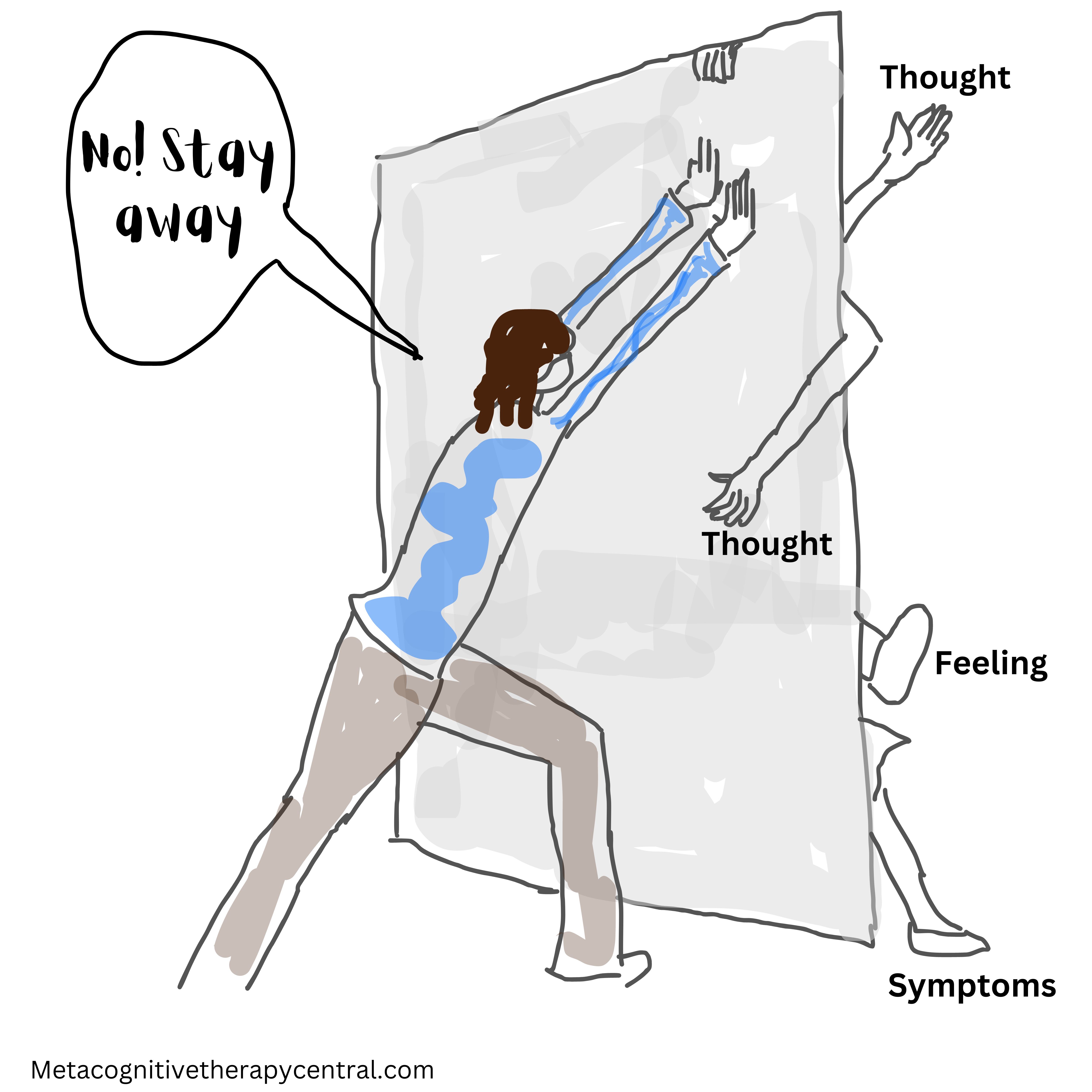
What if I have thoughts about harming myself? What if another OCD thought comes up? The thoughts about my thoughts are making everything feel really confusing.
Some people refer to their intrusive thoughts as OCD thoughts, thoughts about thoughts, or meta-obsessions. But all these names describe the same thing: just another thought out of those thousands of thoughts we experience daily.
Intrusive thoughts can be distressing because we often think they are true. With Metacognitive Therapy, you don’t have to get rid of these thoughts or solve them. Instead, you discover how to see them as fleeting thoughts without any real link to what’s actually happening
Let’s see why this approach is better than trying to fix (get rid of) intrusive thoughts.
The metacognitive model for OCD puts little emphasis on the content of intrusive thoughts but focuses on how a person with OCD relates to them and what they believe about them.

Why shouldn’t you fix intrusive thoughts?
Even though intrusive thoughts can bother you, trying hard to make them go away actually makes things worse. Research shows that when you actively try to get rid of these thoughts, you end up having even more of them (4).
If you doubt this, just think about your own experiences: how often do you succeed in making intrusive thoughts go away by trying to push them aside?
Here is a simple experiment you can do to test if trying to stop thoughts is a good way to make them disappear:
Try not to think of the device you are reading this post on for the next 30 seconds
How well did you do in getting rid of that thought? And if you managed to, was it an easy task? Or did it require a lot of mental effort to avoid thinking about it?
Consistently trying to eliminate intrusive thoughts is one reason you might start feeling weighed down by them. It consumes a lot of mental energy that could be better spent on more meaningful aspects of your life, such as your interests, loved ones, health, work, or studies.
Fortunately, there is a better approach to handling intrusive thoughts through Metacognitive therapy (MCT).
How does MCT deal with intrusive thoughts?
MCT helps you handle intrusive thoughts through these therapy steps:
- Recognize the intrusive thought and leave it alone in your mind.
- Practice not reacting right away to the thought (don’t act on it, don’t overthink it, and don’t try to get rid of it).
- Change your view about intrusive thoughts to be more relaxed by realizing thoughts are just thoughts, not facts.
Step 2 is also used in other therapies for OCD, like Exposure and Response Prevention (ERP). What makes MCT different, however, is steps 1 and 3: not engaging with intrusive thoughts and instead changing how you think about thoughts.

Beliefs about thoughts are important
Metacognitive beliefs about thoughts are learned ideas about what thoughts mean. When it comes to intrusive thoughts, some people believe that their thoughts must be true just because they think them.
I think this, then it must be true
Metacognitive therapy helps you see your thoughts in a more nuanced way. You will learn that just because you think something, it doesn’t automatically mean it is true. For instance, if you have the thought, “What if I harm myself,” having this thought doesn’t actually increase the risk of harming yourself. However, beliefs about thoughts can be formed based on a single experience, like the example below:
Imagine dropping a cookie on the floor at your friend’s house. Even if the floor is clean, your friend might say, Oh no! It’s contaminated! You got this idea from your friend, even if it might not be true. In the future, when you think, The floor is contaminated, you might believe the thought to be true just because of that one experience. You have now formed a belief about your thoughts: thinking something makes it true.
Intrusive thoughts are not facts and they don’t mean that you will act on them. Intrusive thoughts are like silly or strange ideas that pop up and then go away.
Why do intrusive thoughts feel so real?
What if I hurt others? This place is infected and I can get ill. What if I do something irrational? What if I jump off the balcony? What if someone is watching me?
For many people, it’s easy to brush off intrusive thoughts and continue with their day. However, for those feeling very distressed by them or struggling with OCD, moving on from these thoughts can be more challenging. To them, intrusive thoughts seem incredibly real.
The intensity of how real these thoughts feel is linked to the beliefs people hold about them:
When I have an intrusive thought, it feels like a fire is burning that I can’t just ignore
Thinking this makes it so
As long as I am not 100% sure, then what I think could happen
Usually, Intrusive thoughts trigger strong emotions: shame, anxiety, or disgust. The more intense emotions intrusive thoughts bring up, the more convincing they can seem, making it easier to believe that intrusive thoughts are true.
The more anxious I feel when I have the thought, “What if my family gets into an accident”, the more frantically I try to prevent the thought from happening. I will call them hundreds of times, follow the news intensely, and pray for their safety. At those moments I really believe my intrusive thoughts.
Client

Is it abnormal to have intrusive thoughts?
The majority of people experience intrusive thoughts and they are normal and harmless. Intrusive thoughts consist of thoughts, images, urges, and feelings.
Thoughts: what if something bad happened? What if I suddenly don’t remember things? What if my thoughts are true?
Images: Images of accidents, loss, harm, sexual images, bizarre images, or memories
Urges: an urge to move in a specific way or repeat actions and movements
Feelings: feelings of disgust, anxiety, shame, sexual arousal
Intrusive thoughts are random and weird ideas that sometimes pop into your head without you wanting them. Imagine standing on a balcony and getting the thought, “What if I jumped off?”
Why do people get intrusive thoughts?
Generally, thoughts help us communicate, solve problems, and get ready for the future. Intrusive thoughts, even though they can be distressing, seem to have a similar job. They are a tool for survival (2).
Some scientists think that when intrusive thoughts pop up on their own and make us feel scared or disgusted, the goal is to make us avoid risk or danger in the future, and take action to feel safer. For example, thinking that something we touched is contaminated could lead us to wash our hands more (1).
According to these theories, intrusive thoughts are the brain’s way of practicing for possible dangers, but in a safe way (since we are only imagining things, and not really experiencing them). The brain creates these thoughts to keep us safe from what it thinks might be dangerous out there in the world.
It is similar to the body making antibodies to protect us from getting sick.

Do intrusive thoughts ever go away?
Since intrusive thoughts are part of the human learning and thinking system, it is not plausible that they will ever go away. However they can increase or decrease in frequency, depending on how we choose to deal with them.
According to Metacognitive therapy, some thinking styles (rumination, worry, and thought suppression) and behaviors (performing rituals to neutralize thoughts, avoidance behavior, and reassurance seeking) increase the frequency of having intrusive thoughts.
Another name for these thinking styles and behaviors is the Cognitive attentional syndrome, CAS(3). According to the founder of MCT, the CAS seems to increase how frequently we experience intrusive thoughts because it activates a fear response in the brain (3).
For example, if someone actively tries to push away intrusive thoughts that have sexual content (what if I wanted to have sex with my sibling?!), their constant efforts to suppress their thoughts send a message to the brain that there is a constant danger. And the brain responds with anxiety and more intrusive thoughts.
So while it is impossible to expect never to have intrusive thoughts, it is possible to learn to have a relaxed relationship with them and respond to them in healthier ways. (Instead of analyzing them, worrying about them, or trying to make them go away). This leads to relief from intrusive thoughts and recovery from OCD.
What to expect from MCT treatment for intrusive thoughts?
Metacognitive therapy helps you feel more at ease with intrusive thoughts and, at the same time, realize that you have control over whether you worry about them. This means it doesn’t really matter how often thoughts like “What if I decided to harm myself?” or “What if I did something wrong?” pop up, because you don’t take them as seriously anymore. You become confident that you can choose not to dwell on these thoughts and instead, continue with your life.
MCT helps you feel more at ease with intrusive thoughts by using useful strategies like detached mindfulness and changing beliefs about how important these thoughts are. According to a recent study, patients who received MCT spent 9.8 fewer hours in therapy to achieve recovery, compared to patients who received ERP treatment (5).
References
- Abed RT, de Pauw KW. An evolutionary hypothesis for obsessive compulsive disorder: a~psychological immune system? Behav Neurol. 1998;11(4):245-250. doi: 10.1155/1999/657382. PMID: 11568426.
- Wells, A., Personal communication, Oxford, 2023.
- Wells, A., & Matthews, G. (1996). Modelling cognition in emotional disorder: The S-REF model. Behaviour Research and Therapy, 34(11-12), 881–888. https://doi.org/10.1016/S0005-7967(96)00050-2
- Wegner, D. M., Schneider, D. J., Carter, S. R., & White, T. L. (1987). Paradoxical effects of thought suppression. Journal of personality and social psychology, 53(1), 5.
- Melchior, K., van der Heiden, C., Deen, M., Mayer, B., Franken, I. H.A. The effectiveness of metacognitive therapy in comparison to exposure and response prevention for obsessive-compulsive disorder: A randomized controlled trial, Journal of Obsessive-Compulsive and Related Disorders, Volume 36, 2023, 100780, ISSN 2211-3649, https://doi.org/10.1016/j.jocrd.2023.100780(https://www.sciencedirect.com/science/article/pii/S2211364923000015)
